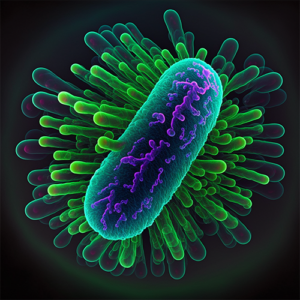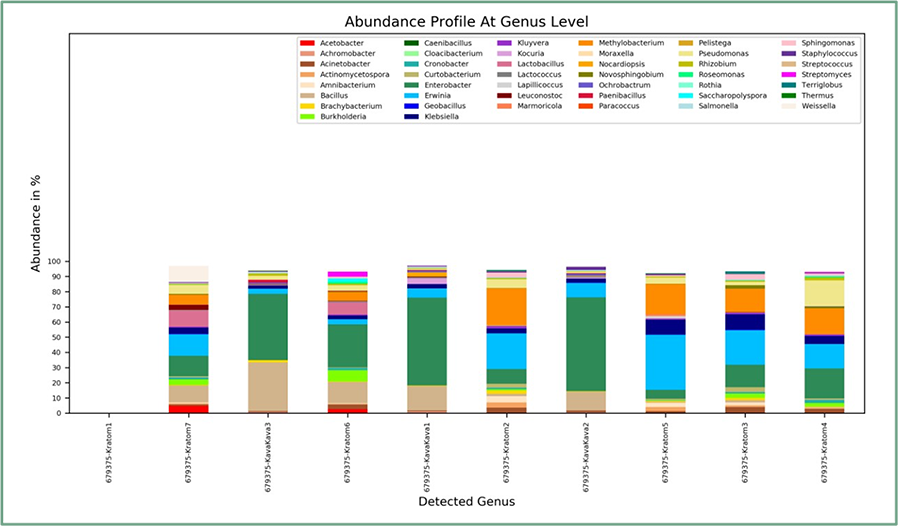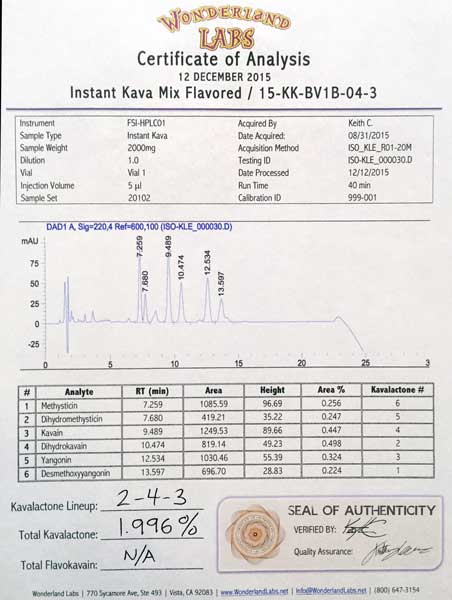FALSE POSITIVES WHEN TESTING KRATOM FOR E. COLI
 After nearly 20 years of testing Kratom (Mitragyna speciosa), we have discovered a few interesting things about testing methods and results for this plant. One critical discovery, is that Kratom tends to produce False Positives when testing for E. Coli. This is true whether it’s the older FDA-BAM Chapter 4 method or the newer USP method.
After nearly 20 years of testing Kratom (Mitragyna speciosa), we have discovered a few interesting things about testing methods and results for this plant. One critical discovery, is that Kratom tends to produce False Positives when testing for E. Coli. This is true whether it’s the older FDA-BAM Chapter 4 method or the newer USP method.
Results for E. coli are a PASS or FAIL result. That theoretically means that results will show positive if even a single cell of E. coli is detected.
The problem for this comes in when we look to other testing results for some raw Kratom powder: From our experience, Kratom is a very “high background noise” material. There can be many reasons for this background noise. What “high background noise” means though, is that raw Kratom powder tends to have a lot of bacteria and other organisms in it, that are not part of the original plant material.
Most Kratom comes from overseas. most is wildcrafted. Most are harvested under less than optimal conditions. With such a massive demand for Kratom worldwide, much of the stock that is brought to the United States has been picked from both trees and forest floors, has been sitting in a warehouse for unusually long periods of time, often in warehouses that are not sealed from the outside world, and so on.
And this is where they key to FALSE POSITIVES FOR E. COLI IN KRATOM comes in. Our extensive DNA testing has revealed that there are a number of strains of E. coli that typically inhabit raw Mitragyna speciosa plant material.
If you look at one of our DNA charts from one of our Kratom DNA tests, you will see the amazing amount of background noise that typically exists in even the freshest harvests of Kratom:

We discovered that there was an abundance of Cronobacter, Erwinia, Enterobacter and Klebsiella present, but no Escherichia in a large number of the samples we tested!
Armed with this information, we set out on a year-long journey, to find a reliable way to have an FDA compliant testing method produce ZERO FALSE POSITIVES while also producing ZERO FALSE NEGATIVES.
It took endless patience, but we eventually found that method.
One of the critical steps in that method is incubating the Kratom powder in a precision water bath instead of a standard incubator. With multiple incubations at slightly different temperatures, we found that we could get rid of most of the background noise that was causing the false positives, while retaining the harmful strains of E. Coli that could cause distress to anyone who consumed a product made from this material.
More On E. Coli in Kratom
There are several different strains of E. coli, but some of the most well-known include:
- E. coli O157:H7: Known to cause severe food poisoning and is often linked to outbreaks of food borne illness.
- E. coli O104:H4: Responsible for an outbreak of food poisoning in 2011 in Europe.
- E. coli O126: Considered less virulent than O157:H7, but can still cause food poisoning.
- E. coli O103: Can cause diarrhea and stomach cramps, but it is generally less severe than other strains.
- E. coli O111: Considered moderate virulent and can cause diarrhea, vomiting, and abdominal cramps.
- E. coli O121: Considered moderate virulent and can cause diarrhea, vomiting, and abdominal cramps.
It is important to note that not all strains of E. coli are harmful to humans, and some strains are actually beneficial. Some examples include:
- E. coli K-12: This strain is commonly used in laboratory research and is considered a non-pathogenic “laboratory workhorse”.
- E. coli Nissle 1917: This strain is used as a probiotic and has been shown to have beneficial effects on gut health.
- E. coli JM109: This strain is commonly used in genetic engineering and biotechnology research, it is a non-pathogenic strain.
- E. coli K12 and E. coli B: These strains are considered non-pathogenic and are found naturally in the gut of humans and animals.
It is important to note that while these strains of E. coli are not harmful to humans, they can still be considered a potential contamination risk in food or plant material. A good manufacturing practice, a proper storage and handling of kratom material can help to reduce the risk of contamination.
Non-harmful strains of E. coli, such as those found in the gut of humans and animals, can get into plant material through a variety of ways:
- Fecal contamination: This can occur when the Kratom comes into contact with fecal matter from animals or humans, either through direct contact or through contamination of water used to irrigate the plants.
- Soil contamination: E. coli can be present in the soil, and can be transferred to the Kratom through contact with contaminated soil.
- Harvesting and processing: If the Kratom is not properly handled and processed, it can become contaminated with E. coli from equipment or workers who may carry the bacteria on their hands or clothing.
- Environmental factors: The presence of non-harmful strains of E. coli in the environment, such as in the air, water, or soil, can also contribute to contamination of Kratom and other plant material.
It is important to note that many of these strains of E. coli are normal inhabitants of the intestinal tract of animals and humans, so it is not surprising that they may be found in plant material. To minimize the risk of E. coli contamination, growers and processors should implement good agricultural practices (GAPs) and good manufacturing practices (GMPs) to minimize the risk of contamination during harvesting, processing, and storage.
This is one of the key aspects to Kratom testing that we feel sets us apart from other labs. Not only have we developed a series of tests specific to Kratom powders, extracts, and liquids, we have built up a portfolio of over 20 years of Kratom profiles. We know what material comes from who and what and where, and this can be a huge asset when you are making critical decisions who you will purchase your Kratom from.
Find out even more in our “Understanding E. Coli Testing” blog post.
NOTE: We do not determine the legality of whether any material is legal for consumption; we simply test for common pathogens and adulterants, and determine whether there are acceptable levels of heavy metals in the material.



 After nearly 20 years of testing Kratom (Mitragyna speciosa), we have discovered a few interesting things about testing methods and results for this plant. One critical discovery, is that Kratom tends to produce False Positives when testing for E. Coli. This is true whether it’s the older FDA-BAM Chapter 4 method or the newer USP method.
After nearly 20 years of testing Kratom (Mitragyna speciosa), we have discovered a few interesting things about testing methods and results for this plant. One critical discovery, is that Kratom tends to produce False Positives when testing for E. Coli. This is true whether it’s the older FDA-BAM Chapter 4 method or the newer USP method.